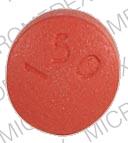Priftin and Alcohol/Food Interactions
There is 1 alcohol/food/lifestyle interaction with Priftin (rifapentine).
Rifapentine Food/Lifestyle
Moderate Food Interaction
ADJUST DOSING INTERVAL: Administration with food may increase the oral bioavailability of rifapentine and reduce the incidence of gastrointestinal adverse events. Administration with a high fat meal typically increases rifapentine's maximum concentration (Cmax) and systemic exposure (AUC) by approximately 40% to 50% over that observed when rifapentine is administered under fasting conditions. Rifapentine is often prescribed in combination with isoniazid. When single doses of rifapentine (900 mg) and isoniazid (900 mg) were administered with a low fat, high carbohydrate breakfast, the Cmax and AUC of rifapentine increased by 47% and 51%, respectively. On the other hand, isoniazid's Cmax and AUC decreased by 46% and 23%, respectively.
MANAGEMENT: Products containing oral rifapentine as the sole ingredient recommend administration with a meal to increase bioavailability and reduce the occurrence of gastrointestinal upset, nausea, and/or vomiting. Consultation of product labeling for combination products and/or relevant guidelines may be helpful if rifapentine is combined with a medication that is typically taken on an empty stomach.
References (2)
- (2021) "Product Information. Isoniazid/Rifapentine 300 mg/300 mg (Macleods) (isoniazid-rifapentine)." Imported (India), 2
- (2021) "Product Information. Priftin (rifapentine)." sanofi-aventis
Switch to consumer interaction data
Priftin drug interactions
There are 499 drug interactions with Priftin (rifapentine).
Priftin disease interactions
There are 3 disease interactions with Priftin (rifapentine) which include:
More about Priftin (rifapentine)
- Priftin consumer information
- Check interactions
- Compare alternatives
- Pricing & coupons
- Drug images
- Side effects
- Dosage information
- During pregnancy
- Drug class: rifamycin derivatives
- Breastfeeding
- En español
Related treatment guides
Drug Interaction Classification
| Highly clinically significant. Avoid combinations; the risk of the interaction outweighs the benefit. | |
| Moderately clinically significant. Usually avoid combinations; use it only under special circumstances. | |
| Minimally clinically significant. Minimize risk; assess risk and consider an alternative drug, take steps to circumvent the interaction risk and/or institute a monitoring plan. | |
| No interaction information available. |
See also:
Further information
Always consult your healthcare provider to ensure the information displayed on this page applies to your personal circumstances.


